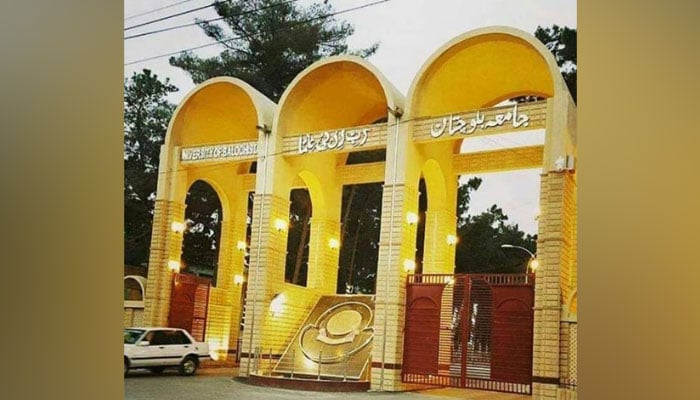How to fix education
One may wonder how Balochistan’s oldest university has become so financially fragile that it does not have funds to pay the salaries and pensions of its employees on time
There is a protest going on outside the University of Balochistan (UoB). Since there is a ban on protests inside the university campus, the protesters, including teachers and other staff members, are holding the protest outside the campus on Sariab Road.
Such protests are now becoming a routine activity for public-sector employees. This time, the university’s employees are out on the streets, demanding the timely payment of their salaries, which the university administration is unable to pay. Last year, the UoB remained closed for months owing to the non-payment of salaries.
The Balochistan government allocates a yearly grant-in-aid as financial assistance for public-sector universities. This amount is distributed as per an agreed formula among the 11 public-sector universities in the country. The budget for this year is Rs2.5 billion.
One may wonder how Balochistan’s oldest university has become so financially fragile that it does not have funds to pay the salaries and pensions of its employees on time.
Multiple reasons have brought things to this point. The university administration blames it on the Higher Education Commission (HEC), which has slashed its budget share per the 18th Amendment. It also complains about receiving meagre funding from the provincial government. This is one side of the story, which, however true to some extent, does not depict the whole picture.
The provincial government last year constituted a high-level reform committee to dig out the reasons for the financial ills of public-sector universities in the province and submitted recommendations for improving the financial sustainability of these higher education institutions (HEIs). The chancellor – ie the governor of Balochistan – also chaired a three-day conference to mull over the financial malaise of the universities and recommend remedies. All the vice-chancellors of the universities gathered in Quetta for three days.
The universities’ reform committee and the vice chancellors’ conference came up with a host of suggestions to overcome the administrative and financial weaknesses plaguing the finances of the universities. They also flagged some issues in their reports.
One such issue is the flagrant violation of the HEC’s guidelines observed in appointments and promotions by the universities. According to the HEC’s Institute Performance Evaluation Report (2021), in certain appointments and promotions, the University of Balochistan relaxed both the criteria of experience and the number of publications required for the promotions. This is not only a violation of the HEC’s guidelines but also a major reason for the plummeting of quality education in universities. Such out-of-turn promotions, indeed, prove to be a drag on the finances of the university to boot.
Similarly, another form of mismanagement is observed in the misuse of scholarship facilities. Back in the Musharraf era, the HEC, in a bid to promote quality education in the higher education sector, introduced a scholarship programme. From 2008 to 2019, around 68 faculty members of the University of Balochistan availed themselves of these scholarships and proceeded abroad for higher education. However, 12 of these faculty members never returned. The university administration has apparently done nothing to bring them back or at least recover the salary amount or scholarship money spent on their studies.
Like any other public-sector entity in Pakistan, public-sector universities in Balochistan face the issue of overstaffing. According to the report by the reform committee, the sole women-only university in the province, Sardar Bahadur Khan Women’s University, had hired 290 employees on contract, while the UoB had hired more than 85 contractual employees.
These are in addition to the employees who have been rehired after their retirement, who not only enjoy monthly salaries but claim pensions as well. It was also recorded with great concern by the committee that some of the statutory positions – which, under the Balochistan Universities Act 2022, are to be filled through a competitive process – are given to the faculty members of the universities.
The positions of pro-vice chancellor, registrar and treasurer in many universities, including UoB, are filled on either an additional charge or an ad-hoc basis. And that too mostly by the faculty members who are professionally academics and not suited for such administrative positions.
The pension allowance also claims a major chunk of the budget of older universities. The UoB administration has mismanaged it big time. The audit of public universities for FY2022-2023 reveals that the UoB has no separate pension fund, due to which commutation and monthly pensions are paid from the recurring grants received from the government.
Furthermore, on July 14, 2021, the university management, without approval from the Senate/syndicate, increased the pension contribution from 45 per cent to 65 per cent, which caused an impact of Rs50 million per month.
For financial sustainability, the annual budget of universities must be properly prepared and discussed at the relevant forums. In the case of public-sector universities, these forums include the finance and planning committees, the syndicate and the Senate. The draft budget prepared by the treasurer’s office is placed before these forums, and detailed discussion is carried out.
All budgetary demands, including the creation of new positions, development initiatives, and non-development budget, are discussed, deliberated upon and approved. Unfortunately, many public-sector universities in the province do not place their annual budgets before the syndicate and the Senate for approval.
Besides pointing out the mismanagement and weaknesses in the administrative and financial systems of public-sector universities, the reform committee and the VC conference also recommended some useful solutions to address these problems and put the universities on the path of financial stability and growth.
One such recommendation was for universities to explore new streams of revenue generation and enhance their revenues at least by 50 per cent from the current levels. Some of these recommendations are briefly mentioned here:
First, universities should explore alternative avenues of income generation to increase sustainable operations. They may undertake research commercialization and establish university-industry links.
Second, technical universities may consider offering their labs for commercial activities like testing facilities to private-sector firms. Third, universities may also consider launching market-driven short courses and trainings and offering consultancy services.
Fourth, universities can consider commercial utilization of the extra land, playgrounds, sports courts, conference halls, auditoriums and other spaces available to them. Fifth, the house requisition allowance to employees who are staying in the university lodges should be stopped.
Sixth, the HEC may devise a policy for the standardized structure of pay and allowances for all public-sector universities across the country. This will stem undue demands from universities’ employees’ associations for the grant of new allowances and remunerations.
The reform committee and the vice chancellors’ conference in their reports also emphasized the establishment of a benevolent fund of Rs100 billion, as a long-term solution to the financial woes of public-sector universities. The proposed funding for the endowment fund is supposed to come from both the federal and provincial governments, during a span of 10 years – 2023-2033.
Certainly, the above-proposed measures offer a robust framework to enhance governance, administrative efficiency, financial sustainability and excellence in academics and research. However, what is more important is the will to implement these recommendations.
All the stakeholders – the federal government, the HEC, the provincial government and, above all, the university administration – have to show their firm commitment to adopting and implementing these recommendations.
The writer is a former secretary of the colleges and higher education department, Balochistan.
-
 Real Reason Andrew Is Unlikely To Move To The UAE Despite Middle East Ties
Real Reason Andrew Is Unlikely To Move To The UAE Despite Middle East Ties -
 Westfield Bondi Junction Hero Inspector Amy Scott Faces Rare Cancer Diagnosis
Westfield Bondi Junction Hero Inspector Amy Scott Faces Rare Cancer Diagnosis -
 2026 Golden Globe Awards: Here's The Complete List Of Winners
2026 Golden Globe Awards: Here's The Complete List Of Winners -
 Malaysia Restricts Access To Grok AI As Backlash Over Explicit Content Widens
Malaysia Restricts Access To Grok AI As Backlash Over Explicit Content Widens -
 Jerome Powell Faces DOJ Criminal Probe As Questions Mount Over Fed Autonomy
Jerome Powell Faces DOJ Criminal Probe As Questions Mount Over Fed Autonomy -
 Blood Pressure Medication Linked With Suicide Risk? New Study Explains
Blood Pressure Medication Linked With Suicide Risk? New Study Explains -
 Justin Herbert Girlfriend Reveals How He Changed Her Life
Justin Herbert Girlfriend Reveals How He Changed Her Life -
 Golden Globes 2026: Julia Roberts Gets Standing Ovation From Audience
Golden Globes 2026: Julia Roberts Gets Standing Ovation From Audience -
 Kensington Palace Releases Statement Clarifying Role Of Prince William’s New Aide
Kensington Palace Releases Statement Clarifying Role Of Prince William’s New Aide -
 Scooter Braun Addresses Public Backlash Over Romance With Sydney Sweeney
Scooter Braun Addresses Public Backlash Over Romance With Sydney Sweeney -
 Cold Weather May Worsen Urinary Problems, Physicians Warn
Cold Weather May Worsen Urinary Problems, Physicians Warn -
 Timothee Chalamet Thanks Kylie Jenner After Winning First Golden Globe
Timothee Chalamet Thanks Kylie Jenner After Winning First Golden Globe -
 Palace On Alert As Andrew, Sarah Ferguson Plan To Sell Royal Family's Valuables
Palace On Alert As Andrew, Sarah Ferguson Plan To Sell Royal Family's Valuables -
 2026 Golden Globes: Nikki Glaser Mocks Leonardo DiCaprio's Notorious Dating Habits
2026 Golden Globes: Nikki Glaser Mocks Leonardo DiCaprio's Notorious Dating Habits -
 Prince Harry 'loved' Seeing Charles, Eyes More Meetings With King: Source
Prince Harry 'loved' Seeing Charles, Eyes More Meetings With King: Source -
 Chad Michael Murray Admits 2000s Fame Could Have 'destroyed' Him
Chad Michael Murray Admits 2000s Fame Could Have 'destroyed' Him




